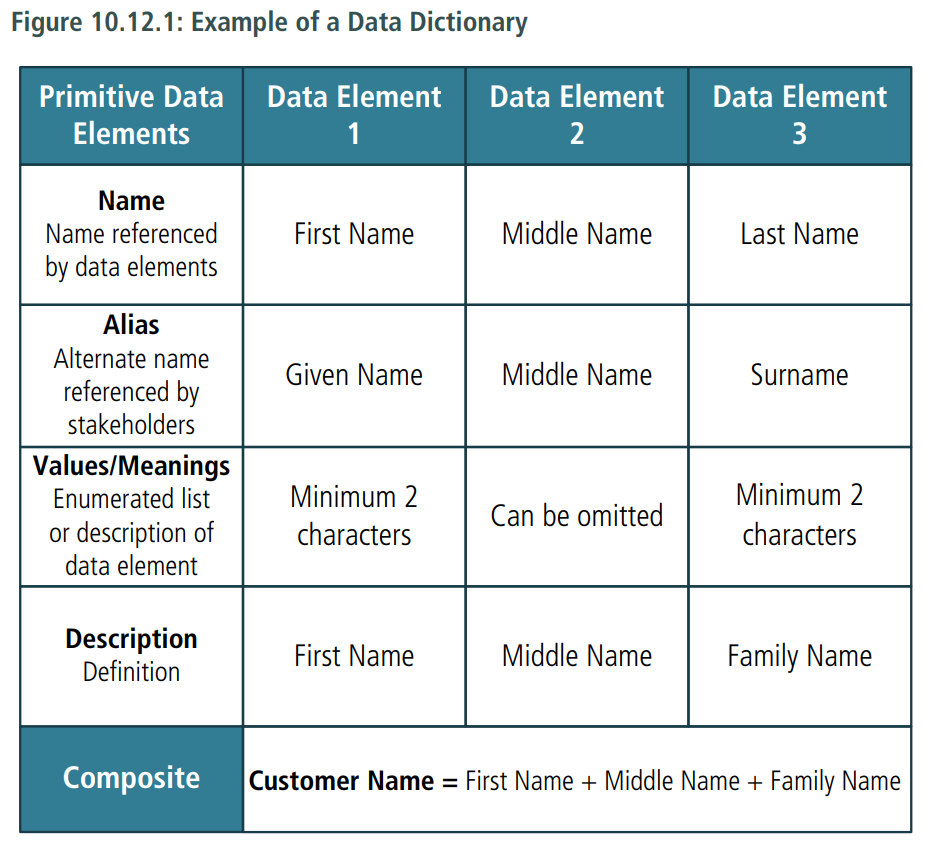10.12.1 Purpose
A data dictionary is used to standardize a definition of a data element and enable a common interpretation of data elements.
10.12.2 Description
A data dictionary is used to document standard definitions of data elements, their meanings, and allowable values. A data dictionary contains definitions of each data element and indicates how those elements combine into composite data elements. Data dictionaries are used to standardize usage and meanings of data elements between solutions and between stakeholders.
Data dictionaries are sometimes referred to as metadata repositories and are used to manage the data within the context of a solution. As organizations adopt data mining and more advanced analytics, a data dictionary may provide the metadata required by these more complex scenarios. A data dictionary is often used in conjunction with an entity relationship diagram (see Data Modelling (p. 256)) and may be extracted from a data model.
Data dictionaries can be maintained manually (as a spreadsheet) or via automated tools.

10.12.3 Elements
.1 Data Elements
Data dictionaries describe data element characteristics including the description of the data element in the form of a definition that will be used by stakeholders.
Data dictionaries include standard definitions of data elements, their meanings, and allowable values. A data dictionary contains definitions of each primitive data element and indicates how those elements combine into composite data elements.
.2 Primitive Data Elements
The following information must be recorded about each data element in the data dictionary:
- Name: a unique name for the data element, which will be referenced by the composite data elements.
- Aliases: alternate names for the data element used by various stakeholders.
- Values/Meanings: a list of acceptable values for the data element. This may be expressed as an enumerated list or as a description of allowed formats for the data (including information such as the number of characters). If the values are abbreviated this will include an explanation of the meaning.
- Description: the definition of the data element in the context of the solution.
.3 Composite Elements
Composite data elements are built using data elements to build composite structures, which may include:
- Sequences: required ordering of primitive data elements within the composite structure. For example, a plus sign indicates that one element is followed by or concatenated with another element: Customer Name = First Name + Middle Name + Family Name.
- Repetitions: whether one or more data elements may be repeated multiple times.
- Optional Elements: may or may not occur in a particular instance of the composite element.
10.12.4 Usage Considerations
.1 Strengths
- Provides all stakeholders with a shared understanding of the format and content of relevant information.
- A single repository of corporate metadata promotes the use of data throughout the organization in a consistent manner.
.2 Limitations
- Requires regular maintenance, otherwise the metadata could become obsolete or incorrect.
- All maintenance is required to be completed in a consistent manner in order to ensure that stakeholders can quickly and easily retrieve the information they need. This requires time and effort on the part of the stewards responsible for the accuracy and completeness of the data dictionary.
- Unless care is taken to consider the metadata required by multiple scenarios, it may have limited value across the enterprise.
